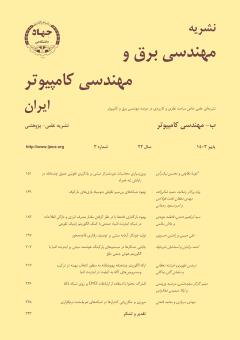بهبود بارگذاری داده ها با در نظر گرفتن مقدار مصرف انرژی و تازگی اطلاعات در شبکه اینترنت اشیاء صنعتی با کمک الگوریتم ژنتیک تقویتی
محورهای موضوعی : مهندسی برق و کامپیوتر
سیدابراهیم دشتی
1
![]() ,
فاطمه مؤیدی
2
,
عادل سالمی
3
,
فاطمه مؤیدی
2
,
عادل سالمی
3
1 - دانشکده برق و کامپیوتر، واحد جهرم، دانشگاه آزاد اسلامی، جهرم، ایران
2 - گروه مهندسی کامپیوتر، مجتمع آموزش عالی لارستان، لار، ایران
3 - دانشکده برق و کامپیوتر، واحد شیراز، دانشگاه آزاد اسلامی، شیراز، ایران
کلید واژه: بارگذاری, اینترنت اشیای صنعتی, الگوریتم ژنتیک, یادگیری تقویتی,
چکیده مقاله :
با افزایش روزافزون کاربرد اینترنت اشیا در زندگی روزمره و مخصوصاً صنعت، بهبود کارایی و زمان تأخیر با کمک بارگذاری دادهها یکی از اهداف این مسائل شده است. کنترل این عوامل باعث بهبود مصرف انرژی و استفاده طولانیتر از باتری اشیا خواهد شد. در این مقاله روشی برای بهبود پردازش دادههای حسگرها و محاسبات لبه و ابر در سیستمهای اینترنت اشیای صنعتی معرفی گردیده و معماری مطابق با دنیای واقعی در نظر گرفته شده است. در این معماری از سرورهای لبه با قابلیتهای محاسباتی در لبه شبکه به ویژه در ایستگاههای پایه استفاده میشود. درخواستهای حساس به تأخیر میتوانند از طریق کانالهای بیسیم به سرورهای لبه نزدیک منتقل شوند؛ در نتیجه ترافیک در شبکه مرکزی و تأخیر انتقال داده کاربر را به ویژه برای برنامههای صنعتی با حجم داده زیاد کاهش دهد. هدف در اینترنت اشیای صنعتی، مدیریت منابع شبکه، انتقال محاسبات و کمینهسازی مصرف انرژی در دستگاههای اینترنت اشیا با تضمین تازگی دادههای حسگر است. محیط شبکه و کارهای ورودی متغیر با زمان هستند. در این مقاله محیط مسئله و محدودیتهای آن با فرمول بیان گردیده و این مسئله با استفاده از الگوریتم ژنتیک و یادگیری تقویتی پیشنهادی حل شده است. راه حل پیشنهادی سبب بهبود محیط پویای مسئله برای بارگذاری دادهها و کارها با در نظر گرفتن انرژی و انتقال محاسبات و دادهها با درنظرگیری تازگی آنها شده است. نتایج نشاندهنده بهبود متوسط 40 درصدی نسبت به روشهای قبلی میباشد.
With the increasing use of Internet of Things in daily life and especially in industry, improving efficiency and delay time with the help of data offloading is one of the goals of these issues. Controlling these factors will improve energy consumption and longer use of things batteries. In this article, the method is introduced to improve sensor data processing and edge and cloud computing in industrial Internet of Things systems. The architecture is considered in accordance with the real world; in this architecture, edge servers with computing capabilities at the edge of the network, especially Used in base stations. Delay-sensitive requests can be forwarded to nearby edge servers through wireless channels, thereby reducing traffic in the core network and user data transmission latency, especially for data-intensive industrial applications. In the Industrial Internet of Things aims to manage network resources, transfer calculations and minimize energy consumption in Internet of Things devices by guaranteeing the freshness of sensor data. The network environment and input tasks are variable with time. In this article, the environment of the problem and its limitations are expressed with formulas. This problem has been solved using the proposed genetic algorithm and reinforcement learning. The proposed solution has improved the dynamic environment of the problem for offloading data and tasks by considering energy and transferring calculations and data by considering their freshness. The results show an average improvement of 40% compared to the previous methods.
